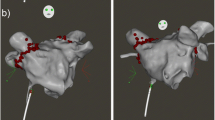Abstract
Access to targets for radiofrequency ablation in patients with congenital heart disease may be limited by anatomy and by surgically placed obstacles. In patients with atrial switch anatomy for d-transposition of the great arteries, the critical isthmus for maintenance of intraatrial macroreentry circuits is found often on the pulmonary venous side of the atrial baffle. A retrograde approach is extremely difficult for these arrhythmias. Use of transseptal techniques for diagnostic catheterization in these patients has been reported. We report the use of a transseptal technique in two cases in conjunction with 3-dimensional electroanatomic mapping for the successful ablation of atrial reentry tachycardias in patients with Mustard and Senning anatomy.
Similar content being viewed by others
References
Van Hare GF. Radiofrequency ablation of accessory pathways associated with congenital heart disease. Pacing Clin Electrophysiol 1997;20:2077–2081.
Delacretaz E, Ganz LI, Soejima K, Friedman PL, et al. Multi atrial macro-reentry circuits in adults with repaired congenital heart disease: Entrainment mapping combined with three-dimensional Electroanatomic mapping. J Am Coll Cardiol 2001;37:1665–1676.
Van Hare GF, Lesh MD, Ross BA, Perry JC, et al. Mapping and radiofrequency ablation of intraatrial reentrant tachycardia after the Senning or Mustard procedure for transposition of the great arteries. Am J Cardiol 1996;77:985–991.
Kanter RJ, Papagiannis J, Carboni MP, Ungerleider RM, et al. Radiofrequency catheter ablation of supraventricular tachycardia after Mustard and Senning operations for d-transposition of the great arteries. J Am Coll Cardiol 2000;35:428–441.
Collins KK, Love BA, Walsh EP, Saul JP, et al. Location of acutely successful radiofrequency catheter ablation of intraatrial reentrant tachycardia in patients with congenital heart disease. Am J Cardiol 2000;86:969–974.
Sokoloski MC, Pennington JC 3rd, Winston GJ, Marchlinski FE. Use of multisite electroanatomic mapping to facilitate ablation of intra-atrial reentry following the Mustard procedure. J Cardiovasc Electrophysiol 2000;11:927–930.
El-Said HG, Ing FF, Grifka RG, Nihill MR, et al. 18-year experience with transseptal procedures through baffles, conduits and other intra-atrial patches. Catheter Cardiovasc Interv 2000;50:434–439.
Author information
Authors and Affiliations
Corresponding author
Rights and permissions
About this article
Cite this article
Perry, J.C., Boramanand, N.K. & Ing, F.F. “Transseptal” Technique Through Atrial Baffles for 3-Dimensional Mapping and Ablation of Atrial Tachycardia in Patients with d-Transposition of the Great Arteries. J Interv Card Electrophysiol 9, 365–369 (2003). https://doi.org/10.1023/A:1027499512211
Issue Date:
DOI: https://doi.org/10.1023/A:1027499512211




